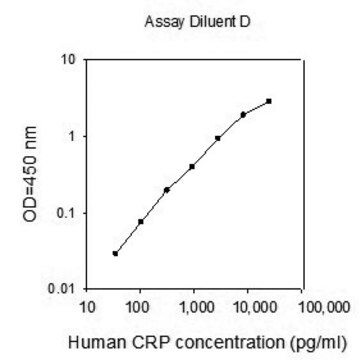EZHS42
High Sensitivity Human Amyloid β42 ELISA
This High Sensitivity Human Amyloid β42 ELISA is used to measure & quantify Amyloid β42 levels in Neuroscience research.
Faça loginpara ver os preços organizacionais e de contrato
About This Item
eCl@ss:
32161000
Produtos recomendados
Descrição geral
Amyloid beta peptides have been implicated in the etiology of Alzheimer’s disease. Amyloid beta 40 is the most prominent peptide and Amyloid beta 42 is the neurotoxic form. The Amyloid beta 42/40-ratio (AB ratio) has been reported as a better indicator of the Alzheimer pathology. Millipore’s High Sensitivity Human Amyloid β42 ELISA kit is used for the measurement of Amyloid β42 in cerebrospinal fluid, cell culture supernatants, primary neurons and plasma in a 96-well format.
Especificidade
The Amyloid β42 ELISA (HS) uses monoclonal anti-Aβ antibodies with high selectivity for human Aβ. The capture antibody recognizes the C-terminal end of Amyloid β1-42, which causes a high selectivity for Aβ42. The cross-reactivity of the used antibodies to other Amyloid peptides was tested by ELISA and BIACORE and shows no significant cross-reactivity to Aβ1-38, Aβ1-39, Aβ1-40, Aβ1-43 and Aβ1-44.
Aplicação
Research Category
Neuroscience
Neuroscience
Research Sub Category
Alzheimer′s Disease
Alzheimer′s Disease
This High Sensitivity Human Amyloid β42 ELISA is used to measure & quantify Amyloid β42 levels in Neuroscience research.
This assay requires 50 µl of sample and is an overnight assay.
Used to detect/quantify: Amyloid β42
Armazenamento e estabilidade
Components in the kit can be stored up to 2 weeks at 2-8°C
Outras notas
Please contact Technical Service for linearity of dilution.
Exoneração de responsabilidade
For research use only. Not for use in diagnostic procedures.
Palavra indicadora
Warning
Frases de perigo
Declarações de precaução
Classificações de perigo
Aquatic Chronic 3 - Met. Corr. 1 - Skin Sens. 1
Código de classe de armazenamento
8A - Combustible, corrosive hazardous materials
Classe de risco de água (WGK)
WGK 3
Certificados de análise (COA)
Busque Certificados de análise (COA) digitando o Número do Lote do produto. Os números de lote e remessa podem ser encontrados no rótulo de um produto após a palavra “Lot” ou “Batch”.
Já possui este produto?
Encontre a documentação dos produtos que você adquiriu recentemente na biblioteca de documentos.
Teresa Niccoli et al.
Current biology : CB, 26(17), 2291-2300 (2016-08-16)
Glucose hypometabolism is a prominent feature of the brains of patients with Alzheimer's disease (AD). Disease progression is associated with a reduction in glucose transporters in both neurons and endothelial cells of the blood-brain barrier. However, whether increasing glucose transport
Gunjan Manocha et al.
Current Alzheimer research, 15(12), 1123-1135 (2018-08-03)
Alzheimer's disease (AD) is associated with age-associated central nervous system degeneration and dementia. This decline in the function correlates with deposition of Aβ peptide containing plaques and associated reactive gliosis. The inflammatory phenotype of microglia, in particular, is often considered
Nataliya Golovyashkina et al.
Molecular neurodegeneration, 10, 60-60 (2015-11-07)
Dendritic simplification, a key feature of the neurodegenerative triad of Alzheimer's disease (AD) in addition to spine changes and neuron loss, occurs in a region-specific manner. However, it is unknown how changes in dendritic complexity are mediated and how they
Kendra L Puig et al.
Journal of Alzheimer's disease : JAD, 44(4), 1263-1278 (2014-11-20)
Alzheimer's disease (AD) is a neurodegenerative disorder histologically characterized by amyloid-β (Aβ) protein accumulation and activation of associated microglia. Although these features are well described in the central nervous system, the process and consequences of Aβ accumulation in the enteric
Loukia Katsouri et al.
Neurobiology of aging, 34(4), 1105-1115 (2012-10-16)
Noradrenergic deficits have been described in the hippocampus and the frontal cortex of Alzheimer's disease brains, which are secondary to locus coeruleus degeneration. Locus coeruleus is the brain stem nucleus responsible for synthesis of noradrenaline and from where all noradrenergic
Nossa equipe de cientistas tem experiência em todas as áreas de pesquisa, incluindo Life Sciences, ciência de materiais, síntese química, cromatografia, química analítica e muitas outras.
Entre em contato com a assistência técnica



